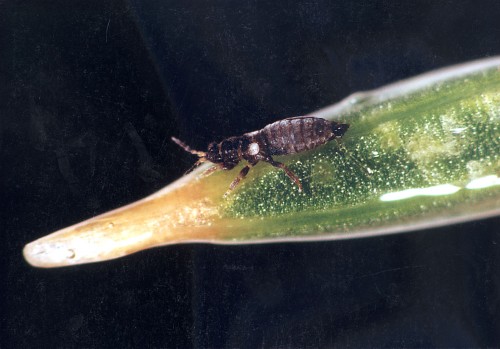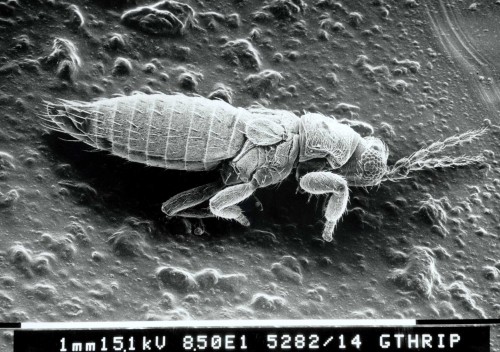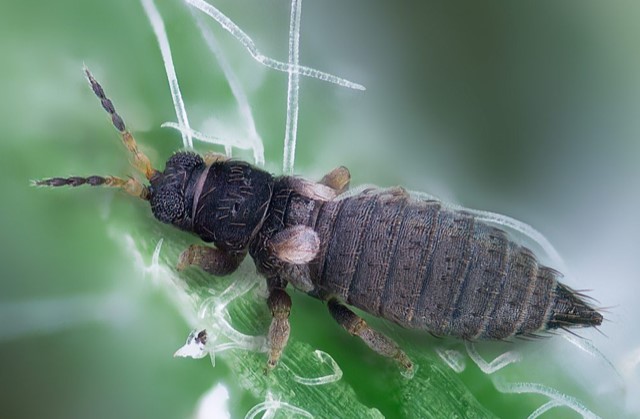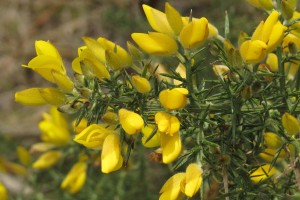Gorse thrips
History in New Zealand
Gorse thrips are native to Europe, and they were first imported from England by the DSIR in 1989. Widespread releases over the next few years saw them become established at sites throughout New Zealand. The thrips were thought to be slow to disperse as winged forms are not as commonly produced as non-winged forms. A second Portuguese strain, that was thought to disperse more quickly, was imported in 2001 and widely released in subsequent years. It has also established. The thrips are becoming increasingly common on gorse throughout New Zealand.
How would I find/recognise it and what is its lifecycle?
You can find gorse thrips on gorse bushes all year round. However, it is easiest to find gorse thrips during the warmer months, especially on the soft new growth. If you have good eyesight, or a magnifying glass, you may be able to see gorse thrips feeding and moving about on the gorse foliage, otherwise you may need to catch some with a beating tray. Place your tray on the ground under the gorse bush. Beat the gorse foliage with a stout stick for 5-10 seconds and then look to see what you have dislodged.
Image: gorse thrips on a gorse shoot.
The adults are tiny (1-2 mm long) and black. The juveniles are cream-yellow and similar in shape to the adults. The juveniles grow and moult several times before developing into less mobile creamy coloured pupae and prepupae. You will not see the eggs as they are hidden in the gorse stems. Egg laying begins in the spring and gorse thrips complete several generations during the warmer months of the year. At 18°C the entire life cycle takes about 6 weeks.

Image: gorse thrip (Sericothrips staphylinus).

Image: gorse thrip (Sericothrips staphylinus) under a microscope.
Avoid looking when flowers and hence flower thrips (Thrips obscuratus) are present. You will not be able to tell the two strains of gorse thrips apart and they are likely to have interbred. Gorse thrips are easy to differentiate from other gorse biocontrol agents or insects on gorse.
See Gorse colonial hard shoot moth, Gorse pod moth, Gorse seed weevil, Gorse soft shoot moth, Gorse spider mite, Native insects that damage gorse.
At a glance gorse thrips look similar to flower thrips. However, you can tell the two species apart by checking three things:
- Wings - gorse thrips generally only have wing buds while flower thrips have full length wings.
- Body shape and size - gorse thrips are short and squat while flower thrips are longer and thinner. As a general rule gorse thrips are about two thirds the length of flower thrips.
- Movement - gorse thrips tend to jump, while flower thrips more commonly walk.
See Insects commonly mistaken for biocontrol agents.
How does it damage gorse?
Both the adult and juvenile forms pierce the surface (epidermis) of gorse stems and suck out the green cells underneath. This results in small white spots that give the gorse a mottled blotchy appearance, which is less obvious than the bleaching caused by gorse spider mites. Gorse thrips prefer new growth, but will feed on older, harder growth as well. When present in good numbers, growth and flowering is reduced and seedlings may be killed.
Will it attack other plants?
No, gorse thrips will only damage gorse.
How effective is it?
We do not yet know the answer to this question. As a rule of thumb most perennial plants have enough reserves to tide them over from an attack by an insect for 1 year. However, if the attack is sustained then plants begin to suffer as they can no-longer compensate for the damage. Gorse thrips have the potential to be damaging to gorse because they tend to stay in one place. While thrips can now be commonly found on gorse, it is less common to see gorse bushes that appear to be severely affected by them. However, studies in the UK and Australia found that gorse thrips could reduce the growth and survival of seedlings, even when present in low numbers, and this may be where they have the greatest impact.
How can I get the most out of it?
Most gorse thrips do not have wings and spread by walking or blowing onto neighbouring bushes. Gorse thrips often disperse slowly, and can take several years to move only a few metres. Occasionally gorse thrips produce winged offspring (possibly when they have over-populated bushes) that can fly away to start new colonies further afield. If thrips are not yet present on your gorse (See I would I find/recognize thrips) you can speed things up by shifting some from an established site. The best time of the year to do this is from October-March, to enable the thrips to recover from the relocation before winter.
How do I select a release site?
Read Guidelines for selecting release sites for biocontrol agents.
How do I collect it for release at other sites?
Read Guidelines for collecting, relocating, and releasing insect biocontrol agents.
You need a pair of secateurs, some stout gloves (preferably leather) to protect your hands from the gorse spines, and paper rubbish bags to put the gorse thrips into. Simply cut off infested branches and put them into bags. Seal the bag thoroughly for the journey to prevent any gorse thrips escaping. The best way to do this is to fold the top of the bag over several times and staple it shut. The more gorse thrips you can shift the better, and the minimum number would be 300 adults. At the new release site, wedge the infested branches firmly into the gorse so the gorse thrips can move across. If the thrips have crawled off the gorse onto the paper bag then rip it up and wedge it in the plant too.
How do I manage the release sites?
Avoid activities that will interfere with the lifecycle of gorse thrips. If you are undertaking gorse control measures over a large area then avoid gorse thrips-infested bushes, or leave some to act as a gorse thrips reservoir to reinfect seedlings and regrowth.
Key contact



